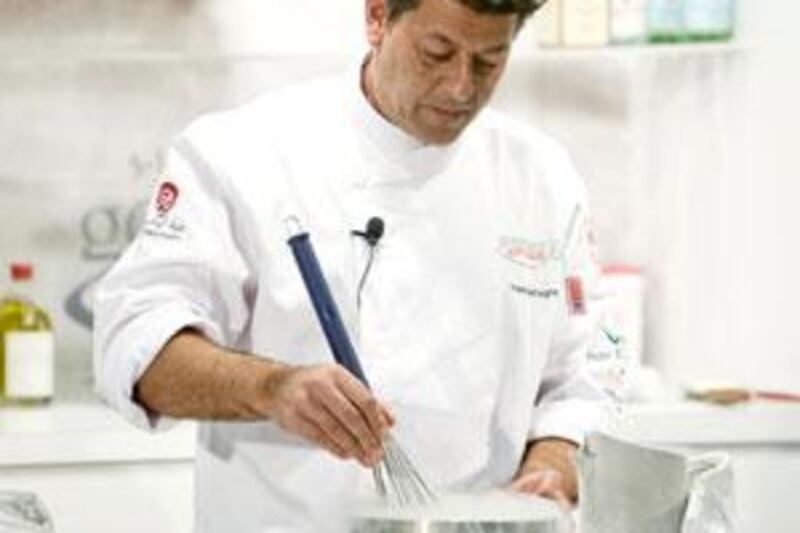An ethereal mist filled the air, which added an atmosphere of mystery to proceedings at the Armed Forces Officers Club. Yet whatever enigmas and conundrums may exist here this week, there will always be someone like Yves Mattagne on hand to provide an explanation. The cloudy white puffs that drifted over the kitchen surface were emanating from a large steel bowl of liquid nitrogen at the two-starred Michelin chef's culinary masterclass. Into the mix went spoonfuls of mango and passion fruit pulp with cream, which emerged frozen into dainty little meringues by the ice-cold solution.
Ordinary household cooks don't tend to keep stocks of liquid nitrogen in their kitchen cupboards. But Yves Mattagne is no ordinary household whisk jockey. The Belgian chef has won a reputation as one of the best in the world at the Sea Grill restaurant in Brussels, not to mention a cabinet-bulging tally of awards. He scooped a gold medal at the Concours European Fish Chef competition in 1992, before being awarded the Chef d'Or Gault Millau in 1994 and the l'Oscar Cuisinier by the Club des Gastronomes de Belgique in 1995. So when he starts playing around with scary chemicals, we can rest assured that he knows what he's doing.
Firstly, he showed us how to prepare Norwegian king crab and pan-seared foie gras with a truffled emulsion. A key component of the dish took the form of bubbly clusters of coconut milk espuma, which involved passing the raw ingredients of puréed potatoes, butter, seasoning and coconut milk through a soda siphon charged with carbon dioxide. The resulting foam boosted not only the appearance of the dish, but also the flavour.
By the time the basin of liquid nitrogen had been brought into the auditorium by a nervous-looking assistant, we were ready for dessert. The mango and passion fruit meringues were achieved by siphoning the processed mixture into quenelles, which were placed into a spoon and lowered into the cold nitrogen. They possessed a fascinating texture somewhere between ice cream and traditional meringue, which only the liquid nitrogen could create, and left me pondering the possibilities of molecular gastronomy without the fear of blowing up my kitchen.
If Mattagne's masterclass had been a lesson in the fine art of contemporary cooking, that afternoon's discussion forum offered excellent advice on how to put such skills to good use in a professional capacity. "What makes a successful restaurant" was the question being asked, and a panel of industry experts was on hand to provide the answers. The world-renowned restaurant consultant Patrick C Willis was the first speaker to take to the stage.
The American chief operating officer of the Marlon Abela Restaurant Corporation (MARC) outlined the importance of research during the early stages. Once a location has been identified, Willis said, the painstaking research of menus, trading hours, interiors and restaurant trends in that area are all vital to the success of a new venture. A robust concept should offer strong USPs (unique selling propositions), while also reflecting the needs of its chosen market.
Willis's track record is impressive. He played a vital role in the launch of Umu Japanese restaurant in London's Mayfair. His measured approach paid dividends when the Kyoto-style fine-dining establishment was awarded a Michelin star within five months of opening. The key to Umu's success has been the addition of a fine head chef, Ichiro Kubota, who hails from Kyoto and spent five years at Tsuruya, which just happens to be the preferred restaurant of the Japanese imperial household.
Also keen to stress the necessity of an accomplished chef was the restaurant consultant Hélène Samuel of Spoonfool Inc. The lady behind some of Paris's most popular contemporary restaurants, such as Delicabar and Cafe Salle Pleyel is also an advocate of a charismatic restaurateur or maître d'. Customers, she said, love to be recognised and called by name. And in an age where technology often takes precedence over good old-fashioned human interaction, a charming and personable restaurateur who understands the unique needs of each customer can give a restaurant a vital edge over its competitors.
For thousands of gourmets, the idea opening a restaurant is likely to remain in the realm of imagination. But some will have left Mattagne's masterclass and the discussion forum with renewed encouragement and plenty of ideas. Your liquid nitrogen might well go up in smoke, but your dreams of opening your own little bistro don't necessarily have to follow. * James Brennan





